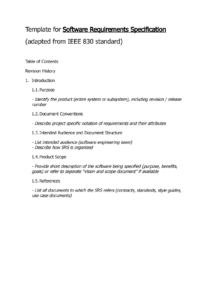Documenting software requirements is crucial for successful software development. A well-defined requirements template ensures that all stakeholders are on the same page and that the developed software meets the intended purpose. In this article, we will provide you with a simple software requirements template that you can use to effectively capture and manage your project’s requirements.
Our simple software requirements template is designed to be easy to understand and use. It includes essential sections for capturing key information such as functional requirements, non-functional requirements, and acceptance criteria. By using this template, you can ensure that your software requirements are clearly defined, complete, and consistent.
Sections of a Simple Software Requirements Template
The simple software requirements template consists of several key sections:
1. Introduction: This section provides an overview of the software requirements document, including its purpose, scope, and intended audience.
2. Functional Requirements: This section describes the specific functionalities that the software must provide. It includes detailed descriptions of input, output, and any specific business rules or processes.
3. Non-Functional Requirements: This section specifies the performance, reliability, security, and other non-functional requirements of the software. These requirements ensure that the software meets the necessary quality standards.
4. Acceptance Criteria: This section defines the criteria that must be met for the software to be considered complete and accepted. It includes specific test cases or scenarios that will be used to verify that the software meets the requirements.
5. Glossary: This section provides definitions of any technical terms or acronyms used in the requirements document. It ensures that all stakeholders have a clear understanding of the terminology being used.
Benefits of Using a Simple Software Requirements Template
Using a simple software requirements template offers several benefits:
1. Improved Clarity and Consistency: A standardized template ensures that all requirements are captured in a consistent and structured manner. This improves the clarity and ease of understanding for all stakeholders.
2. Reduced Risk of Misinterpretation: A well-defined template minimizes the risk of misinterpretations or misunderstandings among team members. It provides a common reference point for all discussions and decisions.
3. Better Stakeholder Involvement: By using a simple and easy-to-understand template, you can encourage active participation from stakeholders throughout the requirements gathering process.
4. Enhanced Traceability: A structured template allows for easy traceability of requirements. You can easily link requirements to specific design elements or test cases, ensuring that all requirements are addressed and verified.
5. Time and Cost Savings: Using a simple and efficient template saves time and reduces the cost of software development. It streamlines the requirements gathering process and eliminates the need for extensive rework due to miscommunication or incomplete requirements.
Conclusion
A well-documented and structured software requirements template is essential for successful software development. Our simple software requirements template provides a comprehensive framework for capturing and managing all relevant requirements in a clear and concise manner. By using this template, you can ensure that your software meets the intended purpose, minimizes risks, and optimizes the software development process.
Remember, investing time and effort in creating a solid software requirements document using our simple template will ultimately lead to a more successful and efficient software development project.

